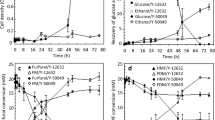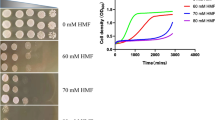Abstract
Saccharomyces cerevisiae served as a model fungal system to examine functional genomics of oxidative stress responses and reactions to test antioxidant compounds. Twenty-two strains of S. cerevisiae, including a broad spectrum of singular gene deletion mutants, were exposed to hydrogen peroxide (H2O2) to examine phenotypic response to oxidative stress. Responses of particular mutants treated with gallic, tannic or caffeic acids, or methyl gallate, during H2O2 exposure, indicated that these compounds alleviated oxidative stress. These compounds are also potent inhibitors of aflatoxin biosynthesis in Aspergillus flavus. To gain further insights into a potential link between oxidative stress and aflatoxin biosynthesis, 43 orthologs of S. cerevisiae genes involved in gene regulation, signal transduction (e.g., SHO1, HOG1, etc.) and antioxidation (e.g., CTT1, CTA1, etc.) were identified in an A. flavus expressed sequence tag library. A successful exemplary functional complementation of an antioxidative stress gene from A. flavus, mitochondrial superoxide dismutase (sodA), in a sod2Δ yeast mutant further supported the potential of S. cerevisiae deletion mutants to serve as a model system to study A. flavus. Use of this system to further examine functional genomics of oxidative stress in aflatoxigenesis and reduction of aflatoxin biosynthesis by antioxidants is discussed.



Similar content being viewed by others
References
Bhatnagar D, Yu J, Ehrlich KC (2002) Toxins of filamentous fungi. Chem Immunol 81:167–206
Bok JW, Keller NP (2004) LaeA, a regulator of secondary metabolism in Aspergillus spp. Eukaryot Cell 3:527–535
Bolwell GP (1999) Role of active oxygen species and NO in plant defense responses. Curr Opin Plant Biol 2:287–294
Campbell BC, Molyneux RJ, Schatzki TF (2003) Current research on reducing pre- and post-harvest aflatoxin contamination of U. S. almond, pistachio and walnut. In: Abbas H (ed) Aflatoxin and food safety. Part I. J Toxicol-Toxin Rev 22:225–266
Cary JF, Harris PY, Molyneux RJ, Mahoney NE (2003) Inhibition of aflatoxin biosynthesis by gallic acid. In: Proceedings of the 3rd Fungal Genomics, 4th Fumonisin, and 16th Aflatoxin Elimination Workshop. 13–15 October, 2003, Savannah, GA., p 51
Estruch F (2000) Stress-controlled transcription factors, stress-induced genes and stress tolerance in budding yeast. FEMS Microbiol Rev 24:469–486
Fernandes L, Rodrigues-Pousada C, Struhl K (1997) Yap, a novel family of eight bZIP proteins in Saccharomyces cerevisiae with distinct biological functions. Mol Cell Biol 17:6982–6993
Grant CM, MacIver FH, Dawes IW (1997) Mitochondrial function is required for resistance to oxidative stress in the yeast Saccharomyces cerevisiae. FEBS Lett 410:219–222
Jayashree T, Subramanyam C (1999) Antiaflatoxigenic activity of eugenol is due to inhibition of lipid peroxidation. Lett Appl Microbiol 28:179–183
Jayashree T, Subramanyam C (2000) Oxidative stress as a prerequisite for aflatoxin production by Aspergillus parasiticus. Free Radic Biol Med 29:981–985
Kozak M (1987) An analysis of 5′-noncoding sequences from 699 vertebrate messenger RNAs. Nucleic Acids Res 15:8125–8148
Lee J, Godon C, Lagniel G, Spector D, Garin J, Labarre J, Toledano MB (1999) Yap1 and Skn7 control two specialized oxidative stress response regulons in yeast. J Biol Chem 274:16040–16046
Levine A, Tenhaken R, Dixon R, Lamb C (1994) H2O2 from the oxidative burst orchestrates the plant hypersensitive disease resistance response. Cell 79:583–593
Mahoney N, Molyneux RJ (2004) Phytochemical inhibition of aflatoxigenicity in Aspergillus flavus by constituents of walnut (Juglans regia). J Agric Food Chem 52:1882–1889
Marchler-Bauer A, Anderson JB, DeWeese-Scott C, Fedorova ND, Geer LY, He S, Hurwitz DI, Jackson JD, Jacobs AR, Lanczycki CJ, Liebert CA, Liu C, Madej T, Marchler GH, Mazumder R, Nikolskaya AN, Panchenko AR, Rao BS, Shoemaker BA, Simonyan V, Song JS, Thiessen PA, Vasudevan S, Wang Y, Yamashita RA, Yin JJ, Bryant SH (2003) CDD: a curated Entrez database of conserved domain alignments. Nucleic Acids Res 31:383–387
Skory CD, Chang PK, Cary J, Linz JE (1992) Isolation and characterization of a gene from Aspergillus parasiticus associated with the conversion of versicolorin A to sterigmatocystin in aflatoxin biosynthesis. Appl Environ Microbiol 58: 3527–3537
Sroka Z, Cisowski W (2003) Hydrogen peroxide scavenging, antioxidant and anti-radical activity of some phenolic acids. Food Chem Toxicol 41:753–758
Sweeney MJ, Dobson AD (1999) Molecular biology of mycotoxin biosynthesis. FEMS Microbiol Lett 175:149–163
Toone WM, Jones N (1998) Stress-activated signaling pathways in yeast. Genes Cells 3:485–498
Tucker CL, Fields S (2004) Quantitative genome-wide analysis of yeast deletion strain sensitivities to oxidative and chemical stress. Comp Funct Genomics 5:216–224
Vogel HJ (1956) A convenient growth medium for Neurospora (medium N). Microb Genet Bull 13:42–44
Wang W, Vinocur B, Altman A (2003) Plant responses to drought, salinity and extreme temperatures: towards genetic engineering for stress tolerance. Planta 218:1–14
Winzeler EA, Shoemaker DD, Astromoff A et al (1999) Functional characterization of the S. cerevisiae genome by gene deletion and parallel analysis. Science 285:901–906
Ying W, Swanson RA (2000) The poly(ADP-ribose) glycohydrolase inhibitor gallotannin blocks oxidative astrocyte death. Neuroreport 11:1385–1388
Ying W, Sevigny MB, Chen Y, Swanson RA (2001) Poly(ADP-ribose) glycohydrolase mediates oxidative and excitotoxic neuronal death. Proc Natl Acad Sci USA 98:12227–12232
Yu J, Chang P-K, Ehrlich KC, Cary JW, Bhatnagar D, Cleveland TE, Payne GA, Linz JE, Woloshuk CP, Bennett JW (2004a) Clustered pathway genes in aflatoxin biosynthesis. Appl Environ Microbiol 70:1253–1262
Yu J, Whitelaw CA, Nierman WC, Bhatnagar D, Cleveland TE (2004b) Aspergillus flavus expressed sequence tags for identification of genes with putative roles in aflatoxin contamination of crops. FEMS Microbiol Lett 237:333–340
Zelko IN, Mariani TJ, Folz RJ (2002) Superoxide dismutase multigene family: a comparison of the CuZn-SOD (SOD1), Mn-SOD (SOD2), and EC-SOD (SOD3) gene structures, evolution, and expression. Free Radic Biol Med 33:337–349
Acknowledgements
We thank J. Cary, USDA, ARS, SRRC, New Orleans, for results of Northern analyses of effects of gallic acid on genes in the aflatoxin biosynthetic pathway and G. Payne, North Carolina State Univ., for results of yeast ahp1Δ complementation analysis. This research was conducted under USDA-ARS CRIS Projects 5325-42000-031-00D and 6435-41420-004-00D
Author information
Authors and Affiliations
Corresponding author
Rights and permissions
About this article
Cite this article
Kim, J.H., Campbell, B.C., Yu, J. et al. Examination of fungal stress response genes using Saccharomyces cerevisiae as a model system: targeting genes affecting aflatoxin biosynthesis by Aspergillus flavus Link. Appl Microbiol Biotechnol 67, 807–815 (2005). https://doi.org/10.1007/s00253-004-1821-1
Received:
Revised:
Accepted:
Published:
Issue Date:
DOI: https://doi.org/10.1007/s00253-004-1821-1




